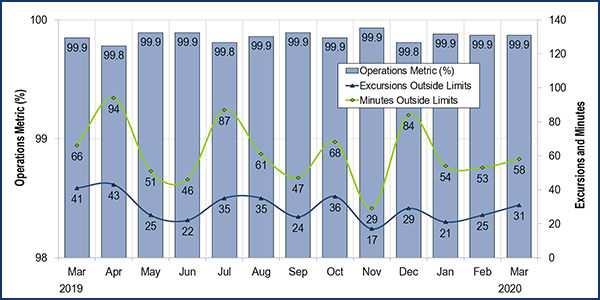The winter of 2019/20 saw PJM with the lowest peak loads of the last seven years, as temperatures 4 to 6 degrees Fahrenheit above the long-term average kept energy consumption down.
Executive Director of System Operations Paul McGlynn told the Operating Committee on Thursday that the highest peak load was on Dec. 19 at slightly over 120,000 MWh, 10,000 MWh below the next lowest peak during the winter of 2015/16.
LMPs were very low all winter, McGlynn said, coming in at an average of $21.31/MWh compared to the next lowest recent number of $26.16/MWh in 2015/16. LMPs exceeded $100/MWh for only three hours over the winter.
For the fourth straight year, natural gas was the primary fuel for generation, with a 38% share, compared to 35% for nuclear, 19% for coal and 7% for renewables. Natural gas overtook nuclear in 2016/17 as the most utilized winter fuel. Gas also passed coal that year as the most utilized fuel during winter daily peak hours.
The relatively mild winter, with few major snowstorms, led to only 12 emergency procedure events during the season, McGlynn said, the lowest total in the last six years. By comparison, PJM saw 43 emergency procedures in 2014/15.
“From an operational perspective, it was a fairly unremarkable winter,” McGlynn said.
Review of Operating Metrics
PJM’s Stephanie Monzon reviewed March’s operating metrics, highlighting that the balancing authority area control error limit (BAAL) performance has exceeded the 99% goal each month in 2020 so far, at 99.9%.
The BAAL standard was created to maintain stable interconnection frequency under normal and abnormal conditions to prevent instability, unplanned tripping of load or generation, or uncontrolled separation or cascading outages.
PJM compares the BAAL excursions in minutes to the total minutes within a month.
Monzon also pointed out the perfect dispatch performance score through March 2020 was 94.81%. Perfect dispatch refers to the hypothetical least production cost commitment and dispatch, achievable only if all system conditions, including load forecast, unit availability and transmission outages, were known and controllable in advance.
The perfect dispatch performance goal was designed to measure how well PJM commits combustion turbines in real-time operations compared to the calculated optimal CT commitment profile. Monzon said the perfect dispatch score has resulted in more than $21 million in savings in 2020.
Monzon said March was a “rather quiet operational month,” with three post-contingency local load relief warnings, four high system voltages and one heavy load voltage schedule action. One spinning event was recorded on March 8, Monzon said, which took place in the Mid-Atlantic Dominion region, lasting a total of five minutes, with a Tier 1 estimate of 1,541.4 MW and an actual response of 660.1 MW.
System Operations Subcommittee Report
PJM’s Rebecca Carroll gave a summary of the most recent System Operations Subcommittee meeting held April 13. Carroll highlighted four high system voltage actions in March, which are typically seen during periods of low loads. PJM will likely continue to see similar events in the upcoming months because of the impacts from the COVID-19 pandemic and the stay-at-home orders, she said.
Carroll said all weeks of the 2020 Operator Seminar have been canceled because of the pandemic. She said if operators need training hours to renew their certification, they should reach out to PJM at TrainingSupport@pjm.com.
While most offices remain closed, Carroll said the PSI testing centers, which administer tests required for PJM training, will reopen about May 1. Masks and gloves will be allowed for anyone going into the training center, she said.
Load Forecast Model Performance
PJM’s Elizabeth Anastasio provided an educational presentation on the performance of the RTO’s neural network machine learning algorithms, which identify the relationship between historical loads and temperatures to create load forecasts. It also considers cloud cover, humidity and the “effective” temperature, a measure similar to wind chill that takes into account wind speed.
What makes a good forecast model, Anastasio said, is a relatively low average error and a bias near 0%. She said bias is calculated by taking the average of hourly errors of over- and under-forecasting to determine the proportion between the two.
Although no model can predict all conditions, accurate models also have relatively few outliers of significant forecasting errors, Anastasio said. She said the best models also don’t see clear trends with outliers occurring at the same time of year or day.
Anastasio said PJM forecasters are constantly trying to assess how to improve load forecasting by looking back at past data as well as current conditions, analyzing outliers and investigating other forecasting methodologies and machine learning.
— Michael Yoder





